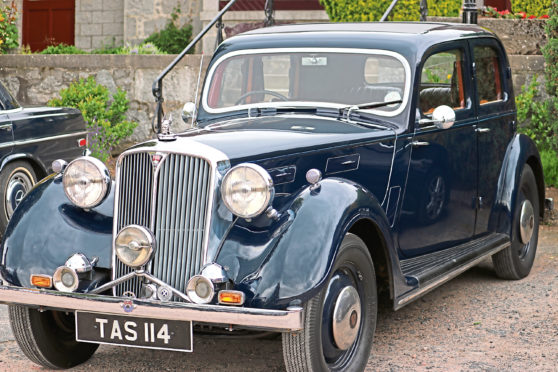Everyone who knows him knows Sandy Dalgarno is a bit of a joker.
So, when he called and asked “would I like to take Tilly out”, I was suspicious.
Then I’m told she is a film star, who at one time, while filming Stone of Destiny, the 2008 adventure/comedy film, had a fling with Robert Carlyle (Hamish Macbeth to you and me).
Fast forward a month and I’ve had two dates with Tilly and can report the relationship is blossoming.
You guessed it, Tilly is a car – a very special car, with her own story and website.
Tilly’s full title is a 1947 Rover P2 16hp Sport Saloon (four light).
A total of 4,028 were built between 1938 and 1947, but now there are only 25 of these cars left in the world and fewer than 10 still on the road.
Tilly herself only returned to our shores in 2003 after being exported to Australia, new, on January 5 1948.
Which means you are very unlikely to see a Rover P2 16hp Sport Saloon on the road unless you were on the A947 when Tilly joined my old Mercedes for a run.
Although there is 25 years between the cars, there are similarities in design you just don’t get on anything modern; look at the slim front pillars, the scattering of lights, the radiator grill and mascots (a Viking and a three-pointed star) are beautifully threatening for pedestrians.
I cannot really describe the joy of sitting in the leather tub chair (with no seat belt) looking along Tilly’s bonnet while trying to keep the Viking pointing in the straight-ahead direction.
“You’re all over the place,” Alice stated the obvious, with some trepidation in her voice.
“I know,” I replied, “But I’m almost touching 50mph, what do you expect?”
To pilot Tilly along the highway and keep her in the zone between the grass verge and the central white lines is like a computer game challenge, albeit employing a totally different analogue skill set.
In fact the PlayStation generation would not recognise the view from the driving seat, nor be able to find and operate the appropriate levers and controls to make Tilly move.
Steering was a surprising challenge.
The large unassisted wheel connected to a steering mechanism which owes more to an ocean-going liner (to match interior) than a motor vehicle was demanding.
This mated to period cross ply tyres and a suspension setup which has more in common with the horse-drawn cart era than automobiles meant I had to concentrate and do a lot of sawing with the wheel.
Although steering on its own could keep me busy, I also have to adjust the mixture for cold start then running, find the trafficators, double de-clutch (press the left-hand pedal twice, match speed to revs and feel the gear lever into the next gear), adjust the free-wheeling hubs (early form of fuel-saving device) and judge braking and changing down to ensure I don’t over overshoot a junction or crash into the car in front.
Thankfully, it was daylight and sunny, so no need to look for and fathom out operating wipers or headlights.
There is an oh-so period radio below the dashboard, but I was so busy driving I was not able to tune it in to Titanic AM.
Sure, she’s a challenge and an older woman, but I’ve fallen for this 1947 screen goddess.
The interior reflects the splendour enjoyed by privileged owners in a bygone era.
You enter over a running board through “suicide” doors (the hinges are at the back) into an opulent cabin decked out in the finest leather and wood.
Inside, the Rover is snug and comfy for two up front in leather-trimmed bucket seats, with enough room to impress two companions in the back.
The wooden dashboard with the aircraft-inspired scattering of dials, switches and buttons is a thing of beauty.
No post-war modern manufacturer can come close to the bespoke coachwork in here.
There is even a highly polished wooden tray in front of the passenger, which when you slide out, you will find the original tool kit inside – lovely.
Tilly’s story can be found at
1947rover.co.uk/Home.html
